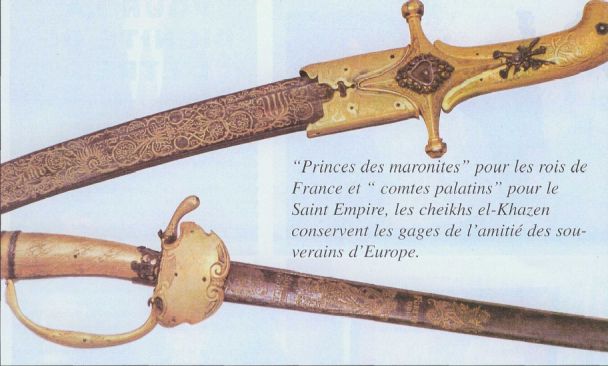The Murr Tower in Beirut is decorated by the Lebanese street artist Jad Khoury with sun clothes in Beirut, Lebanon, May 14, 2018. The Tower is a famous symbol of the Lebanese civil war (1975-1990). Its construction began in 1974, a year before the beginning of the civil war, and until now this about 40-storeys […]
wagingnonviolence.org — Rayyan Dabbous — Following Lebanon’s parliamentary elections on May 6, more than a thousand Lebanese gathered in front of the Ministry of Interior to challenge its official electoral results. According to the Lebanese Association for Democratic Elections, an election monitoring group, there were approximately 7,300 legal complaints, including the removal of its monitors from electoral […]

This article does not necessarily represents khazen.org
BY: MONA SUKKARIEH
The comments made by Israel’s Defense Minister Avigdor Liberman at a Tel Aviv conference on January 31 sparked outrage in Lebanon. It brought the issue of the maritime border dispute between Lebanon and Israel back into the spotlight and managed to catch Washington’s attention once again. Little was happening on this front after the change of Administration in the U.S. After a few months, Lebanese officials stopped announcing that a resumption of mediation efforts was imminent. Then, in October, the decision, by a Total-led consortium to place a bid for Block 9 (which includes a disputed area) in Lebanon’s first licensing round, rekindled interest once again in the topic. But the buzz was discreet, confined to experts and diplomatic circles, until it was out in the open when Liberman described Lebanon’s offshore tender as “very provocative” and urged international companies not to bid, about a month and a half after licenses were awarded. The dispute unfolded in December 2010, when Cyprus and Israel signed a maritime border agreement that was denounced by Lebanon because it encroached on parts of its Exclusive Economic Zone (EEZ). On July 10, 2011, the Israeli cabinet approved a map of Israel’s northern maritime border, and two days later, the Israeli mission to the United Nations submitted a list of geographical coordinates for the delimitation of the northern limit of Israel’s territorial sea and EEZ. Some of the points defined in the Cypriot-Israeli agreement and submitted later to the U.N. overlap with the Lebanese EEZ.
But to understand how we got here, we must go back to 2007. On January 17 of that year, Lebanon signed a maritime border agreement with Cyprus. It followed standard procedure outlined in the UN Convention on the Law of the Sea (UNCLOS), marking a series of points that are equidistant from Cyprus and Lebanon (median line). Point 1 was used to mark the southernmost point along this line, while Point 6 marked its northernmost point. The agreement included a standard clause specifying that the geographical coordinates of the first and last markers, in this case Point 1 in the south, and Point 6 in the north, may be adjusted in light of future delimitation of the EEZ with other neighboring States, since a bilateral agreement cannot pretend to define the borders of third states. The agreement was never ratified by the Lebanese Parliament, largely because of pressure from Turkey, which denounces all maritime border agreements signed by the Republic of Cyprus with its neighboring countries. As such, the agreement never entered into force.
But it wasn’t until April 2009 that a Lebanese commission tasked with defining the coordinates of Lebanon’s EEZ completed its work, identifying Point 23, 17 km south of Point 1, as the southernmost point of the EEZ. The coordinates were approved by the cabinet on May 13, 2009, and by the Parliament on August 4, 2011. In accordance with UNCLOS, Lebanon submitted the relevant charts and lists of coordinates to the U.N. in July and October 2010 and in November 2011. Just like the Israeli submissions mentioned above, these are unilateral submissions and do not amount to border delimitation. Israel objects to the southernmost coordinates submitted by Lebanon. Less known is the fact that Syria also objected to the delineation provided by Lebanon in a letter transmitted to the U.N. Secretary-General on 15 July 2014, saying that it does not have “any binding legal effect on other States. It remains only a notification, and one to which the Syrian Arab Republic objects”.
by lebaneseexaminer.com —Greece is expected to welcome more tourists from Lebanon in 2018, according to travel agencies that participated in the recent ‘Greek Tourism Workshop‘ held in Beirut. Organizers believe the number of Lebanese tourists in Greece is expected to rise by at least 20 percent. “Greek culture has a lot in common with the […]
by businessinsider — The opening of the new US embassy in Jerusalem sparked violent protests in both Gaza and the West Bank on Monday, leaving dozens of Palestinians dead and wounding thousands. Estimates Monday afternoon indicate Israeli forces have killed at least 52 Palestinians and injured more than 1,600. by en.annahar.com — BEIRUT: The […]
by Rabih K lebaneseexaminer.com — Sony Pictures Classics has acquired North and Latin American rights to Lebanese film “Capernaum,” one of the top contenders for the Palme d’Or award, Variety reports. Capernaum tells the story of a young boy who sues his parents for “giving me life in a world of pain and suffering.” The […]

by middleeastmonitor.com Lebanon’s Prime Minister Saad al-Hariri has replaced his chief of staff after his Future Party lost more than a third of its seats in parliamentary elections a week ago. The Future Party won 21 seats, down from the 33 won in the country’s last elections held in 2009. In a post-election speech last week Hariri said the party had been expecting a better result and there had been “gaps” in how it conducted its campaign, for which people would be held responsible. Hariri’s office announced the resignation of Nader al-Hariri, a cousin of the prime minister, late on Saturday. It said Mohamed Mnaimne had replaced him in a temporary capacity.
Despite Future’s losses, Hariri is still the frontrunner to form the next government, as the Sunni Muslim leader with the biggest bloc in parliament. Lebanon’s prime minister has to be a Sunni under its sectarian power sharing system. The Iran-backed Hezbollah group and factions and individuals that support its possession of weapons made significant gains last Sunday, winning more than half the seats in parliament. Hezbollah’s powerful arsenal has been a point of contention in Lebanon for years. The staunchly anti-Hezbollah Lebanese Forces won 15 seats, almost doubling their MPs. The current parliament’s term expires 20 May, and difficult negotiations are expected over the division of positions in the new government.
Hariri Expects to Form Next Lebanese Government
Nabih Berri, the leader of the Amal Movement, who has been the Parliament Speaker since 1992, is likely to be elected to the post for the sixth consecutive time. However, there are still some issues that need to be resolved before the formation of the new government. According to local media, the parliament will convene on May 22 to elect the Parliament Speaker under the presidency of the Lebanese Forces (Phalange) Party and former Deputy Prime Minister Michel Murr. Under the Taif Accord that ended Lebanon’s civil war in 1989, President Michel Aoun will hold talks with Lebanese blocs in parliament to discuss the government formation. According to Taif Accord, the president is elected from among Christians; the prime minister is picked up from among Sunnis and Parliament Speaker will be a Shia. Sources close to Aoun’s Free Patriotic Movement said that Hariri was likely to be chosen to head up the new government. According to the sources, Hariri has the strongest and biggest political bloc among Sunnis.
In a statement, Parliament Speaker Nabih Berri said Hariri was his candidate for premiership, despite his stance on the Ministry of Finance. He said the formation of the new government might be delayed due to the current political issues. Hariri had earlier said the Taif Accord did not stipulate that the finance portfolio be given to a Shia — something Berri had demanded earlier. Samir Geagea, head of Lebanese Forces Party and a former ally of Hariri, said in televised statements that the political agenda had to be set first before Hariri was assigned with forming a government. He asserted that the former government wasn’t that successful. Lebanese political sources said the major issues on the political agenda include shielding Lebanon against political escalations and maintaining security and stability. Hezbollah, with whom Hariri didn’t form an alliance during the election, is expected to oppose Hariri’s premiership.
by AFP — To television viewers, he is the FBI agent who hunts down Al-Qaeda. But in real-life, Ali Soufan is just as extraordinary, a Muslim immigrant who fled war to live the American dream. Born in Lebanon, a child of the West Asian country’s brutal 1975-1990 civil war, he migrated to the U.S. as […]
by reuters — WASHINGTON – The U.S. military is committed to supporting and providing assistance to the Lebanese armed forces, the Pentagon said on Friday, despite the Iran-backed Hezbollah group and its allies making significant gains in parliamentary election. The United States, which has given Lebanon’s army substantial support, classifies the heavily armed Hezbollah as […]
by complex.com JAMES KEITH — Before travelling to Lebanon’s capital of Beirut, I mentioned to some friends I’d be going and, not surprisingly, their reactions became increasingly alarmed the closer it came to my flight. I’d researched as best I could and I could find no reason not to go, but with our government aiming airstrikes at neighbouring Syria, just 50 miles away, I admit I wondered if I was making the right decision. The second I set foot on Lebanese soil, however, I started to feel a bit silly. “There are so many other places that I’ve been that feel sketchy,” says Louis from Chaos In The CBD, “and we haven’t felt that at all while we’ve been here. That’s why travelling is so important, that you experience it for yourself and you’re not fed everything through a television screen.”
Beirut, if you didn’t know, is more-or-less an even mix of Christians and Muslims (both Sunni and Shia), all of whom live side-by-side. Because of that, beautifully grande mosques and ornate churches compete for larger and larger chunks of the skyline. Food-wise, there are even more competing influences — the Mediterranean, North Africa and various areas of the Middle East can all be tasted — as well the true Lebanese originals. Beautifully fresh salads, intensely flavoured meats and gluttonous desserts can be found in literally every direction, on every corner, down every side street. Cafes, restaurants, clubs, shopping malls and apartment blocks seem to crop up daily and the gaps in between those are filled by cranes and scaffolding. Where something new and inviting hasn’t been built, construction workers can be seen remedying that. We didn’t get much time to see that though because we were there for Boiler Room and Ballantine’s True Music: Hybrid Sounds show that, as the name suggest, was a mix of local and international artists as well as a mix of electronic and analogue.




